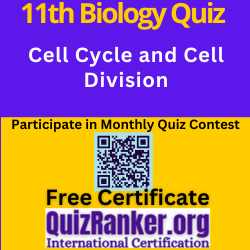Improve your understanding with our Cell Cycle and Cell Division MCQ Test for 11th Biology Chapter 10. This MCQ Test covers mitosis, meiosis, and stages of cell division to help you grasp the process of cellular reproduction.
Attempt Cell Cycle and Cell Division MCQ Test
Attempt Chapter wise 11th biology MCQ Test and Monthly Quiz contest of Biology 11th grade.
Summary for Cell Cycle and Cell Division MCQ Test
According to the cell theory, cells arise from preexisting cells through cell division. This process is essential for growth and reproduction in sexually reproducing organisms, starting from a single-celled zygote. Cell division continues throughout an organism’s life cycle and occurs in a sequence called the cell cycle. The cell cycle has two main phases:
- Interphase: A period of preparation for cell division, divided into:
- G1 phase: Cell grows and carries out normal metabolism; most organelles duplicate.
- S phase: DNA replication and chromosome duplication occur.
- G2 phase: Cytoplasmic growth and preparation for mitosis.
- Mitosis (M phase): The actual period of cell division, further divided into:
- Prophase: Chromosomes condense, centrioles move to opposite poles, nuclear envelope and nucleolus disappear, spindle fibers appear.
- Metaphase: Chromosomes align at the equatorial plate.
- Anaphase: Centromeres divide, chromatids move toward opposite poles.
- Telophase: Chromosomes elongate, nuclear envelope and nucleolus reappear, followed by cytoplasmic division (cytokinesis).
Mitosis results in two daughter cells with the same chromosome number as the parent cell.
Meiosis, in contrast, occurs in diploid cells destined to form gametes and is called reduction division because it halves the chromosome number. Meiosis has two phases:
- Meiosis I: Homologous chromosomes pair up and exchange genetic material (crossing over). It includes:
- Prophase I: Long phase with five stages (leptotene, zygotene, pachytene, diplotene, diakinesis).
- Metaphase I: Bivalents arrange on the equatorial plate.
- Anaphase I: Homologous chromosomes move to opposite poles.
- Telophase I: Nuclear membrane and nucleolus reappear.
- Meiosis II: Similar to mitosis, with sister chromatids separating during anaphase II.
At the end of meiosis, four haploid cells are formed, ensuring genetic diversity and proper chromosome number in offspring when gametes fuse during sexual reproduction.
Chapter wise biology 11th grade mcq
Chapter 1 The Living World MCQ Test
Chapter 2 Biological Classification MCQ Test
Chapter 3 Plant Kingdom MCQ Test
Chapter 4 Animal Kingdom MCQ Test
Chapter 5 Morphology of Flowering Plants MCQ Test
Chapter 6 Anatomy of Flowering Plants MCQ Test
Chapter 7 Structural Organisation in Animals MCQ Test
Chapter 8 Cell The Unit of Life MCQ Test
Chapter 9 Biomolecules MCQ Test
Chapter 10 Cell Cycle and Cell Division Quiz
Chapter 11 Photosynthesis in Higher Plants MCQ Test
Chapter 12 Respiration in Plants MCQ Test
Chapter 13 Plant Growth and Development MCQ Test
Chapter 14 Breathing and Exchange of Gases MCQ Test
Chapter 15 Body Fluids and Circulation MCQ Test
Chapter 16 Excretory Products and their Elimination MCQ Test
Chapter 17 Locomotion and Movement MCQ Test
Chapter 18 Neural Control and Coordination MCQ Test
Chapter 19 Chemical Coordination and Integration MCQ Test
Source for Study
Total Views: 11


